English Version
1. Research Question
What food best represents Chengdu?
2. Method
This round used a card game with food cards and emotion cards. The approach works as a cultural probe, designed to trigger participants’ memories, imaginations, and emotions through play and visual association.
3. Materials
- Food cards (25 items): Hotpot, Malatang, Chuanchuan (skewers), Maocai, Boboji, Rabbit head, Zhong dumplings, Long chao shou, Sweet water noodles, Dan dan noodles, Twice-cooked pork, Mapo tofu, Kung Pao chicken, Boiled beef slices, Fish-flavored shredded pork, Egg pancakes (Dan hong gao), Juntun Guokui (crispy flatbread), Leaf-wrapped rice dumpling (Ye’er ba), Lai rice balls (Lai Tangyuan), Three Cannonballs (San da pao), Bangbang chicken, Husband & Wife lung slices (Fuqi feipian), Gaiwan tea, Ice jelly (Bingfen), Hot and sour noodles.
- Emotion cards (10 items): chill, lively, satisfied, rebellious, calm, surprised, happy, sad, annoyed, lonely.
4. Execution
- Step 1: Each participant receives 25 food cards.
- Step 2: Select 3 foods they feel best represent Chengdu’s local culture. For each, they must pair one or more emotion cards and explain why.
- Example: Hotpot = lively/social; Rabbit head = rebellious/sad; Teahouse = chill/diverse.
- Step 3: Group discussion to decide on the Top 3 food + emotion combinations that best represent Chengdu.
- Step 4: For the 3 chosen combinations, participants are asked: What color do you associate with this?
- Step 5: Final prompt: “Beyond these 25 foods, can you think of any others? If so, which emotions would you pair them with? And what color would this combination give you?”
5. Participant Outputs
Food choices and statements:
- Dan hong gao (egg pancake): Hard to find when studying outside Chengdu; eating it makes one happy and satisfied.
- Chuanchuan (skewers): A Chengdu specialty, rarely seen elsewhere; lively, can cook many kinds of food.
- Maocai: Reminds one of street-side stalls; outside Chengdu it is often confused with Malatang made with milk and sesame paste, very different in taste.
- Twice-cooked pork: A childhood favorite; eating with large slices felt lively and joyful.
- Juntun Guokui (crispy flatbread): First time eating was surprising; crispy with a numbing sensation.
- Sweet water noodles: Strong sense of satisfaction; “rebellious” because outsiders expect Chengdu food to be overly spicy.
- Hotpot: Eaten with friends; lively, a daily choice for gatherings.
- Tea drinking: Symbol of Chengdu’s slow-paced life, chatting with friends in street teahouses.
- Dan dan noodles: Like an upgraded version of zhajiangmian; fragrant, often chosen in daily routines.
- Ice jelly (bingfen): Eaten in summer; linked with a rebellious feeling, like eight-treasure porridge with diverse toppings, giving satisfaction.
Filtering and debate:
- Initial Top 3: Teahouse, Chuanchuan, Maocai.
- Further debate: Participants suggested other foods like Pig’s brain in hot pot, Sichuan pickles, Roasted duck skewers.
- Final Top 3: Teahouse, Sichuan pickles, Roasted duck skewers (Mao Kaoya).



Abstract concept discussions:
- Teahouse color: Green.
- Sichuan pickles color: Multiple views (pink, white, green, red, yellow); consensus that pickles, like Chengdu, are inclusive and multicolored.
- Roasted duck skewers color: Dark red, caramel, or reddish-brown.
6. Reflection
Two moments stood out in particular:
- Maocai vs. Malatang: One participant argued that Maocai may not represent Chengdu clearly. In Northeast China, Malatang is very popular and its preparation is nearly identical to Maocai—the only differences are milk powder in the broth and sesame paste added as seasoning. Moreover, Chengdu itself also has a dish called Malatang. With overlapping names and methods, distinguishing Maocai as uniquely Chengdu is difficult. To avoid confusion and to ensure international audiences can easily recognize the food as Chengdu’s, participants decided to exclude Maocai from the Top 3. This highlighted the importance of considering both local meaning and external recognition when choosing cultural symbols.
- Pickles as metaphor: In the discussion on Chengdu pickles, participants were initially locked into the “pink = radish” frame. One participant broke the pattern by asking: What vegetables are actually in the pickle jar? This reframed the conversation—reminding everyone that pickles include beans, ginger, chilies, cabbage, etc. The color, therefore, cannot be singular but multicolored. One participant concluded: Pickles should be represented by multiple colors, just like Chengdu—diverse and inclusive.
This insight struck me deeply. The pickle jar is like an international city, such as London—able to hold multiple customs, perspectives, and lifestyles. It is not defined by one color but by the coexistence of many, just like nature itself. Yet, I also realized that inclusion does not mean unconditional acceptance. Just as a pickle jar can host many vegetables but not rotten ones, cities need boundaries in their inclusivity. Chengdu pickles reminded me that the vitality of an international city comes not only from openness and diversity, but also from its ability to uphold values and principles.
7. Iteration Toward Fashion Translation
At this stage, I have gathered 3 symbolic Chengdu foods (Teahouse, Sichuan pickles, Roasted duck skewers), along with associated colors and emotions. The next step is to abstract these food symbols into fashion language, exploring how sensory, emotional, and cultural elements can translate into clothing forms.
Prepared materials:
- Photographs of the Top 3 foods.
- Color keywords: green (teahouse), pink/white/green/red/yellow (pickles), dark red/caramel/reddish-brown (roasted duck skewers).
- Blank fashion croquis for sketching silhouettes.
Task:
Participants will select one food and translate its elements (taste, color, atmosphere, emotional keywords) into a fashion symbol, sketching it onto the croquis. They must also consider how these elements communicate within a global fashion identity.
Discussion:
- Each participant explains why they translated the food this way.
- Group debate: Which fashion symbol best represents Chengdu’s distinctiveness in a global context?
Outputs:
- 3–5 “Chengdu food → fashion element” samples.
- Initial conclusions on how Chengdu’s cultural symbols can enter fashion narratives through color, material, and atmosphere.
Chinese Version
设计第二轮intervention
- 明确本轮研究问题:什么食物最能代表成都?
2. 方法设定:通过食物卡牌 + 情绪卡牌来引导参与者思考,本质上就是用“文化探针”来触发他们的记忆、想象和情绪。
3. 准备诱导思考的材料(确保材料能触发冲突/想象/对话) —— 食物卡牌选择25种典型成都食物(火锅、冒菜、串串香、麻辣烫、钵钵鸡、兔头、钟水饺、龙抄手、甜水面、担担面、回锅肉、麻婆豆腐、宫保鸡丁、水煮肉片、鱼香肉丝、蛋烘糕、锅盔、叶儿粑、赖汤圆、三大炮、棒棒鸡、夫妻肺片、盖碗茶、冰粉、酸辣粉)+情绪标签10个(chill、热闹、满足、叛逆、平静、惊讶、开心、难过、烦躁、 孤独)
4. 现场执行
第一步给每位参与者在25张食物牌选; 第二步在其中选出3张最能代表成都本土文化的食物;食物选出后要求参与者为每个食物配对情绪卡,并解释原因;
例如:火锅=热闹 社交 兔头=叛逆 难过 茶馆=chill 多样化
第三步共同讨论Top3食物+情绪组合最能符合心目中代表成都的食物; 第四步接下来询问参与者对筛选出的这3组,分别感觉是什么颜色? 第五步最后除了以上25种食物你们还能想到其它食物吗?如果有请问是什么?你觉得它如何与这10张情绪牌中的那些牌配对?最后大家觉得这组食物+情绪的组合给你的颜色感觉是什么颜色?
5. 参与者输出
- 食物选择与发言:
- 蛋烘糕:发言者在外地读书时想吃困难,想到其味道开心,吃到满足。
- 串串:成都特色,外地少见,形式热闹,可煮各种菜。
- 冒菜:看到图会想起街边支锅的市井状态,外地吃到的多是加奶或麻酱的麻辣烫,与成都冒菜味道差异大。
- 回锅肉:发言者从小爱吃,大刀回锅吃起来开心、热闹。
- 军屯锅盔:第一次吃很惊讶,口感脆且有麻麻的感觉。
- 甜水面:满足感强,因与外地人对成都人爱吃辣的印象不同,有 “叛逆” 感。
- 火锅:可与朋友一起吃,热闹,是日常聚餐的常见选择。
- 喝茶:体现成都慢节奏生活,可与朋友街边喝茶摆龙门阵。
- 担担面:类似升级版炸酱面,吃起来香,多在生活平淡时选择。
- 冰粉:夏天吃有 “叛逆” 感,像喝八宝粥,有很多小料,吃起来满足。
- 筛选与辩论:
- 初步筛选:讨论后筛选出茶馆、(冷锅)串串、冒菜三个选项。
- 继续辩论:参与者提出其他食物如毛脑花、四川泡菜、冒烤鸭等,继续辩论并替换部分选项。
- 最终 TOP3:最终选出茶馆、四川泡菜、冒烤鸭为最能代表成都的 TOP3 食物。
- 抽象概念探讨:
- 茶馆颜色:有人认为是绿色。
- 四川泡菜颜色:有粉红色等多种看法,大家认同这个泡菜坛容纳了多种蔬菜很难用一种颜色表示。因此大家都认同粉红色/白色/绿色/红色/黄色为泡菜的颜色,就其像成都一样包容。
- 冒烤鸭颜色:多数人认为是酱红色、焦糖色或红褐色。
6. 活动结束后反思
在测试过程中,让我学习到了许多以及反思了许多,其中有两个片段让我印象深刻。
首先,有参与者提出 冒菜并不适合作为最能代表成都的食物。原因在于,东北有一道非常流行的菜叫“麻辣烫”,其做法与冒菜极为相似——区别只在于汤底里多了牛奶和奶粉,出锅后多了麻酱。而成都也有一道菜同样被叫做“麻辣烫”。在这种名称重叠和做法相近的情况下,要清楚地区分“冒菜”和“东北麻辣烫”并不容易。为了避免产生歧义,也为了确保代表成都的食物在外部视角下能够一听就认同,参与者最终放弃了冒菜作为 Top 3 之一的选择。这让我意识到,在挑选文化符号时,不仅要考虑本地人熟悉的意义,还要兼顾外部受众的理解与认同度。
其次,是关于成都泡菜的一次讨论。当我们试图用颜色去表达泡菜给人的感受时,一开始大家都被“粉色”这个答案带进了同一个固定画面:想象泡菜坛子里泡的是萝卜,粉红色是萝卜皮,白色是萝卜心。于是大家的思考都局限在萝卜这一种食材上。然而,一位参与者却跳出了这个框架,他说自己在思考:泡菜坛子里到底泡的是什么菜?这立刻启发了大家——对呀,泡菜里还可以有豇豆、姜、辣椒、白菜等多种食材。既然它们都统称为泡菜,那它的颜色就不该只有一种,而是多种颜色的叠加。最终,当大家陷入“到底选哪种颜色最能代表泡菜”的困境时,这位参与者提出:泡菜就应该是多彩的,就像成都这座城市一样,包容而多元。
这句话让我深受触动。我突然意识到,泡菜坛子其实像极了国际化城市——例如伦敦。它能同时包容不同的习俗、兴趣、视角和生活方式,不是单一的颜色,而是如同自然界一样丰富多彩的存在。但进一步思考让我明白,真正的“包容”并不是毫无边界的接纳。就像泡菜坛子可以容纳多样的蔬菜,却不能放进腐坏的食材一样,城市的多元性也需要底线。成都泡菜因此给了我一个启发:一座国际化城市的生命力,不仅来自它的开放与多样,还来自它在拥抱多元的同时,能够坚守自身的价值与原则。
7. 研究搜集与转化迭代
目前已经得到3种能代表成都的食物、多种颜色、情绪。现在需要通过抽象化美食符号,转换为时尚语言并观察参与者联想差异。
- 准备材料:
- 成都的美食如果变成时尚,会是什么样子?If the cuisine of Chengdu were to become fashionable, what would it look like?
- TOP3 食物(茶馆、四川泡菜、冒烤鸭)照片 + 颜色关键词(绿色、粉红/白色/绿色/红色/黄色、酱红/焦糖/红褐色)。
- 几张空白的模特人体图,希望探索更多的服装廓形。
- 任务说明:
- 请参与者选择一个食物,把它的特色元素(味觉、颜色、氛围、情绪词)转译为一个时尚符号,画在图上。
- 需要考虑到全球fashion identity的差异化。
- 讨论环节:
- 每个人分享为什么用这种方式表达食物 → 时尚。
- 辩论:哪个“时尚符号”最能代表成都在全球 fashion identity 中的差异化?
- 产出:
- 至少得到 3–5 个“成都美食转译为时尚元素”的样本。
- 形成一个初步结论:成都的文化符号如何通过色彩、材质、氛围进入时尚叙事。
Leave a Reply